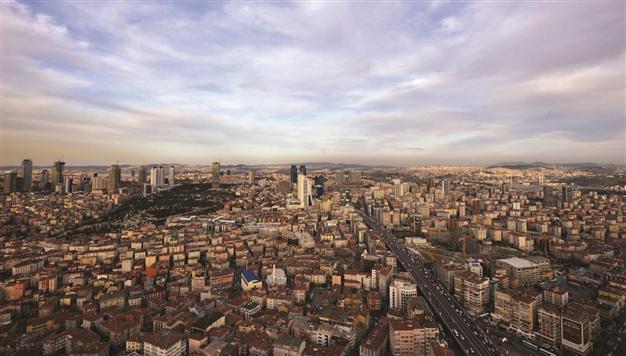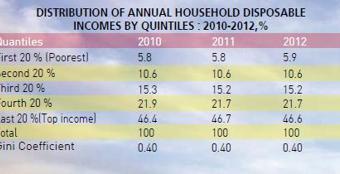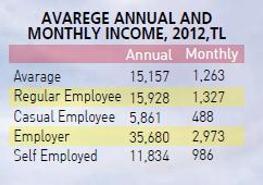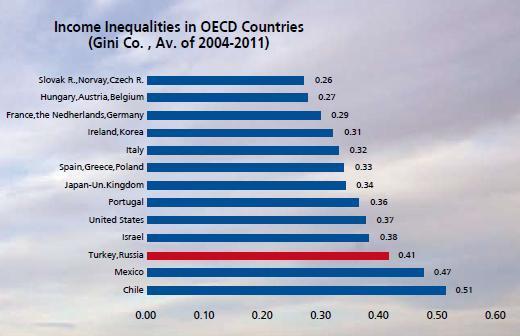Is income disparity just 8-fold in Turkey? You should think again
MUSTAFA SÖNMEZ Hürriyet Daily News

According to the OECD data, Turkey is among the countries which have unequal income distribution. And Turkey’s unrealiable data have resulted in several inefficiencies in calculating the number of poor people and the rate of poverty in the country. DAILY NEWS Photo / Emrah Gürel
Turkey’s income distribution survey is based on announcements by participants. As the incomes declared by wealthy classes and upper or middle income groups are below their real incomes, the accurate numbers appear to be 320 billion Turkish Liras ($178 billion) lower than the estimates.
Unreliable data has resulted in several inefficiencies in calculating the number of poor people and the rate of poverty in Turkey.
The TÜİK data is used by many international institutions from the International Monetary Fund (IMF) to the World Bank and the Organisation for Economic Co-operation and Development (OECD) as these institutions take the data seriously. Even some programs are recommended based on the data.
According to the OECD data, Turkey is among the countries which have unequal income distribution, even if it is not the most unequal. The Gini co-efficient is used to find out how equal the income distribution in a country is. The closer the Gini to 1, the more unequal the income distribution in a country is. And the closer the co-efficient is to 0, the more equal the income distribution in a country is.
Among OECD nations, Chile has the least equal income distribution with a Gini co-efficient of 0.57, followed by Mexico. Turkey and Russia are ranked third with a Gini co-efficient of 0.41.
To be sure, nobody can know how reliable the data from other countries is, but Turkey’s income distribution survey suffers from serious methodological setbacks. The absolute value of the collected data is far from overlapping with the realities of life. TÜİK, however, makes this survey every year and there is no improvement in the method’s quality, as far as we’ve known.
The findings of the survey stem from what the participants share. Researchers ring doorbells, asking the head of the family how much money has entered the house. The researcher writes what these people say. If the participant is a worker, s/he declares her/his income. Is it possible, however, to be able to say (much) wealthier people do the same? Have a look at the table.
When regular (waged) employees were asked how much money they earned in 2012, they said 15,157 liras annually on average, 1,263 liras ($702) on a monthly basis, which is reasonable. There are, of course, many people who are paid higher, but we need to remember here the minimum wage is around $450 in Turkey.
What about employers? Such people said they earned 36,000 liras a year on average, 3,000 liras ($1,667) on a monthly basis! How can we believe such announcements?
 Incomplete cake
Incomplete cake
We are talking about a big population composed of many from employers who employ dozens of workers to people who run business groups worth millions of dollars. Is it realistic that they earn just 3,000 liras ($1,667) a month? It’s not, of course. What about self-employed people? Their monthly income is not above 1,000 liras ($555), according to TÜİK data. This group is composed of freelance engineers, doctors, contractors and jewelers, among others, but the data says their monthly income is lower than 1,000 liras! TÜİK accepts these announcements as true. Agency officials take the income declarations from households, dividing the total figure into five societal segments to find out who takes how much from the income cake.
The first problem here is that the resulting cake was incomplete as upper-middle income groups, namely wealthier classes, declared lower-than-real incomes. How do we know? It’s very easy.
Turkey’s national income was 1.4 trillion liras ($778 billion) in 2012, but the TÜİK data showed people earned around 880 billion liras ($500 billion), around 12,000 liras on a monthly basis. There was a huge difference between these figures.
To be sure, some part of the national income is not “usable income” as it does not enter households. Even if we take 85 percent of the national income, the difference is around 30 percent. Some 320 billion liras ($178 billion) are not counted, entailing some really huge missing part of the real income disparities.
The wage of regular employees has not increased greatly. Some inflation-adjusted raises have been made, but in small amounts. The income levels of the top 5 percent, specifically 1 percent of Turkey’s population, has, however, been skyrocketing. These groups do not, however, declare their real incomes when a TÜİK researcher asks. TÜİK officials take the income declarations from households, dividing the total figure into five societal segments, and then say there was an eight-fold difference between the top and the bottom.
 Poverty figures
Poverty figuresTÜİK’s income distribution surveys also reveal poverty figures. Turkey’s poverty figures are calculated by using the same unreliable data, based on just the household’s income announcements, resulting in a miscalculation of the real poverty rates. TÜİK officials arrange the income brackets from the top to the bottom using income announcements. The segment in the middle is called the “median income level.”
The annual income per capita (the median income) was around 9,000 liras ($5,000) in 2012, or 746 liras ($414) on a monthly basis, according to TÜİK data.
TÜİK takes 60 percent of the median income as the relative poverty line. For instance, the annual poverty line was 5,373 liras ($985) in 2012, or 448 liras ($249) on a monthly basis. People who earn below this line were counted as poor people. Some 16.6 million people were under the line in 2012, around 22.6 percent of the whole population, although some 17 million people were said to be under the line in 2006, 25 percent of the then-population. Thus, some people claimed that the rate of poverty had decreased around 2.5 points, around 500,000 people, during the last six years of Justice and Development Party (AKP) rule.
Many wealthy people, however, do not disclose their real income when they are asked to do so, causing some dramatic differences between the real income disparities and the announced disparities, meaning that the number of poor people is recorded as lower than the reality. Is it reasonable to say the median income was 748 liras ($415) in Turkey in 2012? This was even lower than the minimum wage. And people who earned 448 liras ($249) were listed as poor people, totaling around 16.6 million, 23 percent of the population. Who believes this?
61 pct of households indebted Some 40.6 percent of the respondents to the TÜİK survey said they had some problems like leaking ceilings, moist walls and other complaints. What is more, some 61.3 percent of the respondents said they were indebted.
Some 86 percent of all respondents said that even they could only “imagine being able to go on holiday away home.”


 Incomplete cake
Incomplete cake  Poverty figures
Poverty figures